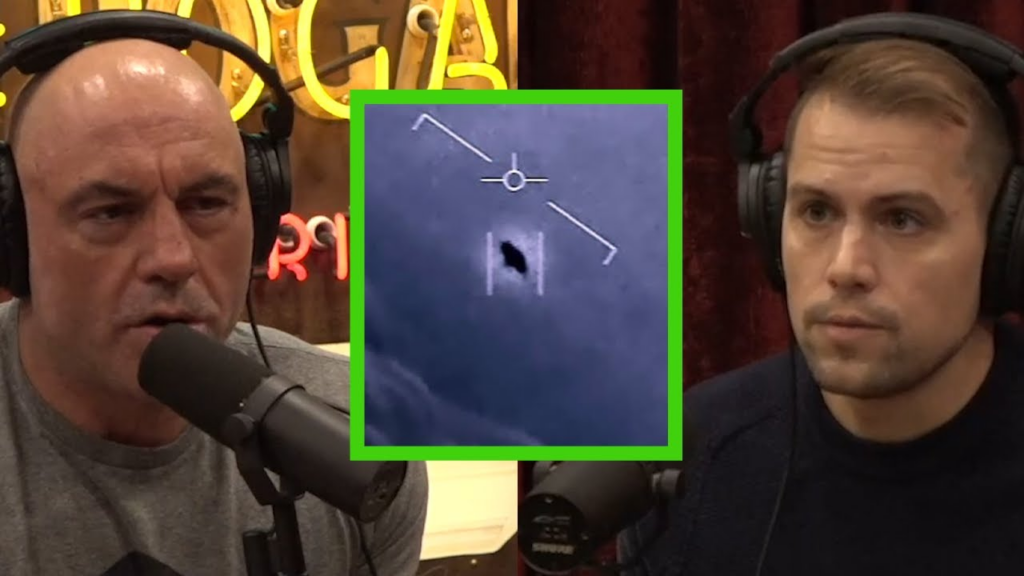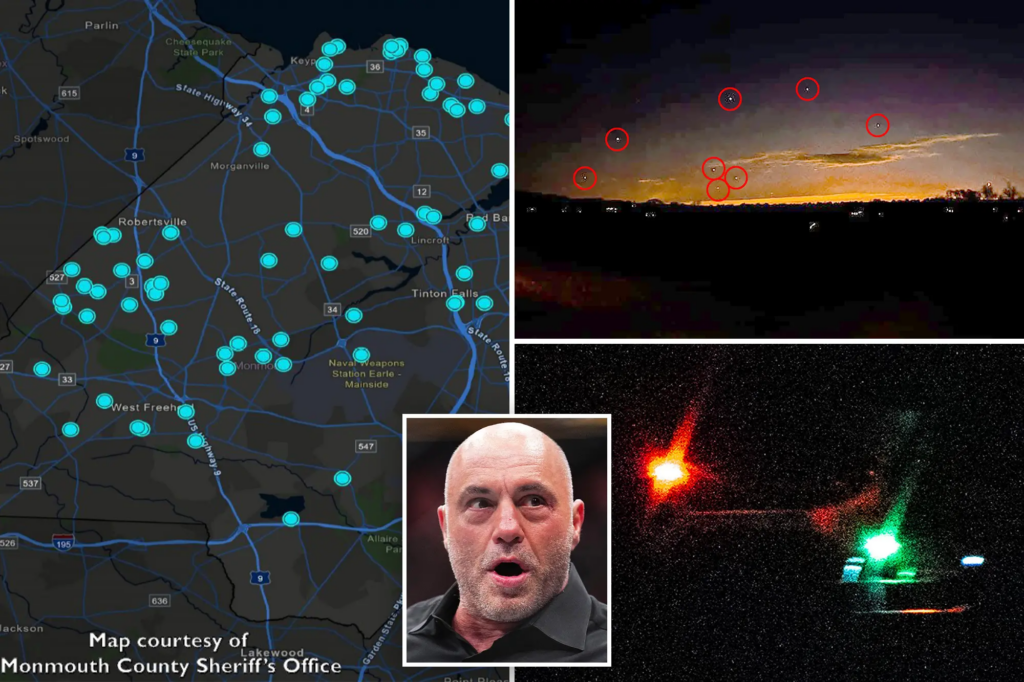Joe Rogan left stunned as Navy pilot reveals secret tech powering drones over New Jersey’
A former Navy pilot has weighed in on the drone sightings in New Jersey as the mystery rages on.
Ryan Graves, a former lieutenant, appeared on the Joe Rogan Podcast where he discussed possible technologies powering the drones, which would allow them to avoid detection.
He told Rogan that law enforcement has been unable to pick up the objects with their infrared systems, suggesting the drones are using ‘some type of signature management’ to reduce heat emissions.
‘We do this in fighter jets… where we cover the engine to essentially make it harder to see, but to have zero ability to detect or lock onto these objects is not the technology I’m familiar with,’ said Graves.
The pilot pointed how the objects are not behaving like normal aircraft, such as their High-G force maneuvers that include sharp turns, climbs and dives.
‘Then they remain in the area for another five or six or seven hours and still have the battery life or whatever’s propelling them to then go over the ocean to a point where they’re untrackable again. I’m not really familiar with that type of capability,’ he said.
Graves became a household name in the UAP world in 2023 when he became the first active-duty pilot to come forward publicly about regular sightings of UAP.
He testified in front of Congress that year, claiming to have had firsthand encounters or knowledge about secret government programs involving technology that is ‘non-human.’

‘The word on the street is that these objects appear to be coming from over the ocean, said Graves during the podcast.
‘There’s senior congressmen, Coast Guard personnel, law enforcement [who are] seeing a large number of these come from somewhere over the ocean.
‘I don’t know if that means necessarily they’re popping out of the water physically or if they’re coming from some unknown location in the water and then proceeding over the coast.’
‘They are flying very low, in some cases they seem to be operating as a group in the vicinity of each other. They are emitting energy or not so you know like radio communications or their own.
‘It’s unknown I’ve poked on that front and best I can tell the government doesn’t know either.’
The sightings began mid-November with the first sightings over Picatinny Arsenal in Rockaway.
Rogan said that ‘it is so weird’ that the drones are a mystery to the White House.
Graves offered some explanations, suggesting that the drones might be using cameras to measure their surroundings instead of radar, which is more easily detectable.
‘They could have a self-contained navigational system with their onboard maps and they’re using cameras to map where they are,’ he said.
Rogan asked if the technology would make them completely autonomous, to which Graves said: ‘Exactly.’
‘I could imagine a fully self-contained autonomous drone system that is doing something potentially with passive sensors that allows it to operate without emissions, which is going to make it harder to track,’ he said.
Rogan asked why the powers of be have not put a stop to the drones, and the former pilot said it all comes down to the laws in the US.
While the White House has yet to provide the public with answer, it has been holding classified briefings on the matter.
‘Because of that they essentially need a warrant in order to wiretap these,’ Graves said, explaining that is the feedback he has received.
‘[They need a warrant] to even intercept these signals that they may or may not even be emitting to be able to determine where they’re going.’
He explained that base commanders have to submit a request to the Secretary of Defense, making it ‘a super politically charged situation.’
‘If they take action and shoot one of these down even with this the Secretary of Defense’s permission you know they’re on the hook if that thing takes out a school bus or otherwise damages someone’s property kill somebody,’ said Graves.
Rogan began the Tuesday podcast by discussing the different narratives surrounding the mysterious sightings.

‘The scariest one that I’ve heard is that their drones are looking for gamma radiation because there’s a missing nuke. Let’s address that one first please,’ he said.
Rogan had been quiet about the New Jersey drones until John Ferguson, who runs Saxon Unmanned, posted a TikTok video claiming the craft was looking for either a gas leak of ‘radioactive material.’
Graves told the podcaster that he has interacted with individuals who work on weapons of mass destruction and they told him that ‘there’s not a loose nuke or other type of weapon of mass destruction that these objects are pursuing right now.’
‘Otherwise they’d be working in a skiff nonstop to make that go away,’ he added.
The response, however, did not hit home with Rogan who questioned if Graves’ sources were being truthful.
‘How [did] they persuade you? Just by saying ‘that’s not the case’ or have they given you any information that leads to this conclusion,’ Rogan asked.
Graves replied that the people he spoke to would be the ones responsible for finding the nuke or weapon of mass destruction.
The mayor of Belleville, Michael Melham, had said on Fox TV’s ‘Good Day New York’ Tuesday that the drones may be looking for radioactive material.
‘It was a shipment. It arrived at its destination. The container was damaged, and it was empty,’ Melham said.
The mayor was referring to an alert from the US Nuclear Regulatory Commission (NRC) that said a piece of medical equipment used for cancer scans went missing on December 2 during transit through the state.
The device, known as a ‘pin source,’ contained a small amount of Germanium-68 (Ge-68)used to calibrate a medical scanner’s accuracy.
The pin source contained about 0.267 millicuries (mCi) of Ge-68, which is a very small amount that would only cause harm during close and prolonged exposure.
The material emits low-energy gamma radiation, making it useful for calibration purposes in medical equipment.
The Civic compact car has been a long-time favorite among our staff for its effortless balance of practicality, value, and driving fun. The 2025 Civic receives styling tweaks to keep it looking fresh and it gains a hybrid variant, updates that aid it in returning to our 10Best list for another year. In the Civic Hybrid, a 2.0-liter four-cylinder with two electric motors provides a combined 200 horsepower, and the car is rated at up to 49 mpg combined. A 150-hp 2.0-liter four-cylinder is now the only engine option for the nonhybrid models, and it lacks zeal but also provides impressive fuel efficiency.
Sedan and hatchback body styles are available, and the Civic provides agile handling and a well-balanced ride no matter which version you choose. The lower-trim nonhybrid versions have a comprehensive roster of driver-assistance features as standard, but you’ll have to step up to the more expensive Hybrid Sport and Hybrid Sport Touring models to get nicer equipment and better infotainment features. Though the 2025 Civic hit the streets running, it faces competition from the recently refreshed Hyundai Elantra and the alluring Toyota Prius, as well as its arch-rival, the Toyota Corolla.
The Civic receives a few cosmetic changes to keep its styling looking fresh for 2025. Revised headlamps and a reworked bumper help visually identify the new model year from last year’s Civic. The bigger news is the addition of the Civic Hybrid. The hybrid powertrain is optional on the Sport trim level and standard on the top Sport Touring trim level. The nonhybrid model, now limited to LX and Sport trims, will be offered only with the nonturbo 2.0-liter four; last year’s turbocharged 1.5-liter has been discontinued. The manual transmission is also no longer available in the Civic hatchback, meaning a stick-shift is now reserved for the sportier Civic Si and Civic Type R models.



